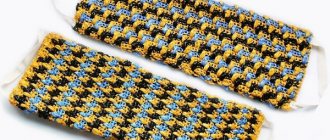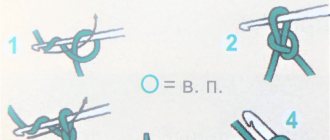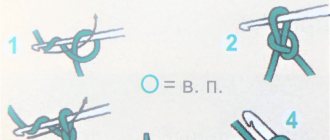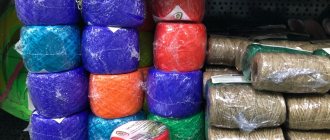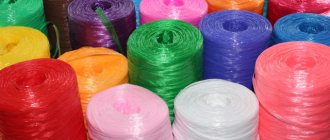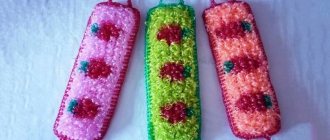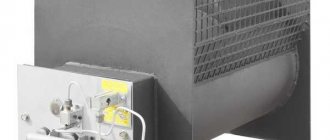There is no way to do without such a necessary thing as a simple washcloth in the household. We simply need it in everyday life. It is impossible to live without it in the bathroom and kitchen. There are many types of washcloths, such as smooth, fluffy, straight, cylinder-shaped, and round. There is a large selection of these products of all types in the trading network, but you can not spend money from your home budget and knit any one you like with knitting needles.
This type of knitting will not require large material costs, because you will only need synthetic threads and knitting needles (hosiery or with stoppers). In this article you will learn how to knit washcloths of several common types. This is a straight, elongated loop (P), a cylindrical and round pipe. Such products are knitted from fairly stiff synthetic yarn. To conclude the article, we will talk about smooth washcloths knitted using fabric strips.
Master class on knitting a straight washcloth from elongated loops
Let's prepare synthetic threads of bright colors, as well as ordinary straight knitting needles No. 3. For the first row (R), we cast on 30 P, and knit 5 P with stockinette stitch. Starting from the sixth P, we will begin to perform extended P. They can be done using two techniques, on the left or on the right hand:
We invite you to watch the following video master class, which gives a complete understanding of knitting elongated loops.
You can perform a front P, alternating 1x1 elongated and regular P. In the next 7th purl P, we knit exclusively with facial loops (LP). We knit the eighth R like the sixth. In the future, it is necessary to alternate rows six and seven, that is, we will do it according to the following scheme until the required length of the product is reached:
Read
Step-by-step instructions for knitting baby booties
When finishing knitting, you need to make the last 5 P in stockinette stitch, as at the beginning. We will need strings, and we will tie two thin strips. For each we cast on 40 P, and after knitting three P with stockinette stitch, we close the row. We connect the finished lines with a washcloth with threads.
Video: Learning to knit elongated loops
Photos of beautiful do-it-yourself washcloths for showers and baths
Children's washcloth
A high-quality bath accessory can be made from both artificial and natural materials. Most often, harder materials are chosen; they will slightly scratch the surface of the skin. This washcloth is designed for rubbing and gently massaging the skin.
But in principle, to make washcloths yourself, you can take different threads of quality and thickness that you have at hand. They should be selected depending on the required density and rigidity.
For very delicate women's or children's skin, you can make a washcloth using natural wool, such as sheep or goat. It is best to take unpainted natural homemade material. When using woolen products, you should not immerse them in too hot water, only warm or cool. Otherwise, the product will shrink and become rough and hard.
Figure 2 – Washcloth crocheted from regular threads
To achieve an anti-cellulite effect, you should take a harder material, which will give a better effect of massage and rubbing.
The most versatile material for making washcloths at home is polypropylene yarn, which has different thicknesses, stiffness and density. In principle, this is the same twine, but presented in reels and having less rigidity. You can try to make a washcloth from it, but it will be too rough. True, twine also varies in density.
Polypropylene options have a lot of poles:
- They do not need special care, are not afraid of high temperatures, except boiling water;
- Water entering the fiber does not remain in it, so such washcloths dry quickly enough;
- They are not a breeding ground for bacteria;
- The paint does not wash out over time, and the finished product will not fade.
Among the disadvantages, one should be highlighted - artificial origin, but this material does not cause allergies, since it is chemically neutral.
How to knit a washcloth with elongated loops in the round
The tubular washcloth has the shape of a cylinder and is knitted with elongated U made of synthetic threads. To knit it, you need to prepare fairly stiff synthetic yarn of bright colors, as well as stocking needles for knitting in the round:
We begin needlework with a set of 32 P, after which we distribute them onto 4 stocking needles and knit in the round. In this case, there are 8 stitches for each knitting needle. We knit in the same way as in the first master class, alternating stitches with elongated stitches and rows of knit stitches. We knit the first and last stitches with stockinette stitch, as in the first case. At the end we also make thin ropes, or replace them with a thin ribbon that matches the color of the yarn. If desired, you can put foam rubber inside and sew up the ends of the cylinder. The presence of foam rubber inside leads to the fact that it foams well.
Materials
The choice depends on what kind of washcloth you want to make, as well as who will use it. There are many yarn options. If you knit a washcloth with knitting needles made of polypropylene rope, the product will turn out to be rough and hard. Not everyone will like it, especially if it is intended for a girl with delicate skin.
Jute threads are positioned as an environmentally friendly material. But an allergic reaction often occurs to it, including during knitting. I don't consider this option.
On the Internet you can see how to knit from bags. But things take time. And not everyone will understand a gift made from plastic garbage bags, right? So I choose the path of least resistance. These are ready-made polypropylene threads specifically for knitting washcloths. They are much thinner than a rope. But at the same time very durable. I liked the beige threads as the main color, as well as the brown skein for the stripes.
I won’t knit a washcloth in two threads, because then the washcloth will be too dense. The idea was to make a freer product. That's why my knitting needles are 5 mm. They are long. Because on short stitches very often the loops slip off the working needle.
How I see my washcloth. This is a small square with a fur pattern with elongated loops. They will be on one side. On the other hand, I plan to make a handle in the middle so that I can put it on my hand.
Round washcloth with elongated loops
This adorable sponge is very convenient because it has a round shape. When knitting, a garter stitch pattern is used. Let's start working by casting on 20 P on regular knitting needles. We need to make a rectangular-shaped fabric. At the beginning of every second P we add 1 P, and at its conclusion we knit 2 P together once. As a result of this technique, the shape of the product is rounded. Next, dial 5 P for the handle, and knit a strip 15 centimeters (cm) long. We tighten the ends of this cord and sew them together. Then we connect both ends with threads.
Read
Types of melange yarn and its use in knitting
How to choose threads
The best yarn for washcloths is single- or double-twisted polypropylene, but threads that are natural in composition are even more valued. The yarn should be strong and smooth. The thicker the thread, the stronger the product.
- Jute. Eco-friendly washcloths are knitted from it. Jute yarn is made from the fibers of an annual plant grown in India and Egypt. A jute washcloth is moderately hard, it absorbs water well and lathers up. Daily exposure of jute to the skin stimulates blood circulation and improves metabolic processes in the dermis.
- Hemp. Yarn made from hemp stem fibers. Its properties are similar to flax, but at the same time more durable and lighter. Products made from it do not lose their shape and do not stretch when exposed to moisture.
- Lyko. It is made from linden or willow wood fibers. These washcloths are suitable for sensitive skin.
- Loofah. Yarn made from grass fibers. Its effect on the skin is difficult to overestimate: pore cleansing, anti-cellulite massage, cell regeneration. At the same time, such a washcloth turns out to be very tough. The loofah holds its shape well, quickly soaks in water and lathers well.
- Sisal. Agave fiber. Like any natural yarn, it has a beneficial effect on the condition of the skin, but due to its increased rigidity, it is recommended to use this accessory no more than twice a week. The disadvantage of sisal is that it takes a long time to dry.
- Linen. The most delicate material, suitable for baby washcloths, but before use, such an accessory must be steamed with hot water.
- Cotton. Most often it is used for washcloths for babies. Such products are short-lived, but cotton is best suited for children's skin.
- Capron. Such threads are usually thin, so they are knitted in several layers. The products are durable, but tend to stretch.
- Polyethylene. For knitting, it is better to use industrially produced yarn, but experienced craftswomen can also indulge in creativity using homemade “threads” from ordinary plastic bags. The advantage of such washcloths is moderate rigidity and durability. The downside is poor absorption and the possibility of skin allergies.
Smooth massage sponge made of knitted yarn
This smooth sponge is knitted from strips of fabric that can be made in a variety of ways. But first, let's choose a suitable fabric that won't fray at the edges when cut. When it comes to knitting, it is best to use synthetic pieces of old clothing or tights. It is necessary to choose the largest piece of fabric so that when cutting you get a long ribbon without knots.
There are many ways to cut any piece of knitwear. The first technique involves moving the scissors in a spiral. Cutting a piece from one corner, we move to the nearest corner. In the second corner we turn the scissors and cut at an angle of 90 degrees. So we move, cutting the piece from the edge to the middle. In this case, you need to cut off the corners and ensure that the strips are of equal thickness:
You can cut the fabric into serpentine strips. At the same time, we start cutting from any corner and move to the opposite corner. Not reaching the second edge by a couple of centimeters, turn the scissors 180 degrees and cut in the opposite direction. Using this technique, we cut the fabric to the very end, and you also need to round the corners. We wrap the finished elements into a ball and begin to perform them with a set of 11 P.
Let's make 8 P with a garter stitch pattern.
If you have stripes of different colors, then continue making 10 R with the second shade. Next, go back to the first fabric color.
We alternate the shades of fabric yarn to get this color. Then close the P of the last row and sew three strips to the ends.
We braid a braid from these strips, and make the same braid on the other side of the washcloth.
A little history and purpose
It is not known for certain when the first devices appeared to help cleanse the skin, but already in references in Babylon and Ancient Greece there is information about the first washcloths. Wealthy people used wood or bronze to wash their skin, while poor people used bunches of plants or sand.
Now, a washcloth is already an absolutely necessary household item for every person. Beautifully designed, of different sizes, colors and purposes, they decorate the bathroom and are indispensable assistants in the bathroom.
A washcloth can be made from any available material: natural cotton or chintz, using old terry towels, woven from burlap, and for those who are not looking for easy ways - knitted.
Video lesson:
Single layer washcloth
When knitting this washcloth, elongated loops are knitted on both sides. To obtain a more fluffy washcloth, knitting was carried out in two threads. That is, two skeins are used or one, then the second end is additionally pulled from the inside. After casting on an air row of loops, a row of stitches with one crochet is knitted.
The next row is knitted without double crochet. After the third row, we begin knitting with elongated loops, forming them with the thumb. In the last stitch of the row, a single crochet stitch is knitted. After turning the work over, the next row is knitted with similar elongated loops, and they end up on the opposite side of the product.
Secrets of a simple but beautiful knitting of a bath accessory
Materials
Today the market is replete with all kinds of knitting materials. But the choice is not so easy to make. It is especially difficult for beginner needlewomen. I will talk about popular raw materials intended for knitting washcloths.
An excellent material is bast. It consists of linden fibers extracted from the inside of the tree and combined into threads. Washcloths knitted from natural raw materials:
- durable and wear-resistant;
- practical and environmentally friendly;
- lathers well and smells good;
- have a beneficial effect on the body;
- They cleanse the skin well of impurities and dead cells.
Thus, products made from bast must certainly be present in the bath suitcase of steam gourmets!
A good material for creating a bath accessory is a loofah. The washcloth is known for its rigidity, which is why it has an anti-cellulite, regenerating, cleansing, exfoliating and stimulating effect on the skin. In addition, the product has a long service life and washes well.
Video lesson:
Washcloth without elongated loops
Work begins with a set of 30 air loops. The resulting chain is looped, and two rows are knitted with single crochets. The next row is knitted with single crochets. Next, the main pattern is knitted, consisting of three double crochets, with a gap of two double crochets between them.
The result is a beautiful pattern that also closes into a ring. This three-stitch pattern is repeated on all subsequent rows until the remaining length of the washcloth is knitted. The washcloth ends, as it began, with two single crochets. The washcloth is almost complete, all that remains is to tie the handles.
Video lesson:
Double crochet washcloth
The product is knitted in the round and has two layers. Using double crochets allows you to knit a washcloth twice as quickly and at the same time reduce thread consumption. The washcloth turns out to be soft, gentle, and quite comfortable to wash with. Threads to create the product were used in two colors, since the product is made with a gradient.
We knit with two threads using crochet number 5. 35 air loops are cast on and closed with a ring. The next row is knitted with single crochets. Then the elongated loops are knitted with a double crochet. To make the loops elongated, they are formed using the thumb. The stitches knit together very quickly. Subsequent rows are knitted similarly.
Video lesson:
Crocheted washcloth
This master class is designed for those who do not know how to knit at all. The training begins with a story about how to properly hold the hook, ensuring its movement. The initial loops are also described in detail. The result is a chain of air loops, connected by a ring that serves as a cuff for the product. A row of single crochets is formed; five rows is enough.
In the next rows, elongated loops begin to form, which are draped over the thumb. The technique for creating these loops is discussed in detail on the screen. Further rows are knitted exactly the same until the washcloth reaches the specified length. You can change the color of the thread.
Video lesson:
Lush loofah
To make the washcloth look fluffy, you need to use a polypropylene thread folded in half. We begin the work with a set of thirty air loops and connect them with a ring. We knit a single crochet into each of the air loops. In the next row, single crochets alternate with single crochets. Then the same pattern is repeated.
Video lesson:
Round washcloth for bathing
The washcloth-mitten, made of threads of various colors, resembles a fancy flower. To make it neat and fluffy, we work with one thread. We start with five air loops, which are looped and after one lifting loop are knitted in a circle using single crochets. In the next row, already elongated loops are knitted between the columns of the previous row, securing them with single crochets.
After the air lifting loop, a row is formed with single crochets, increasing their number: one and two stitches are knitted into cells in turn. Then a whole row of elongated loops is knitted again. Gradually other colors are included, and in the photo the washcloth resembles a flower.
Video lesson:
Tricolor washcloth
The washcloth, painted in the colors of the Russian flag, is knitted from special yarn for washcloths. We cast on 35 loops, this number will determine the width of the washcloth. The chain of loops is closed, and you can start knitting in the round. The first rows are simple, they form the cuff of the washcloth.
Next, elongated loops of the same size begin to form in the rows, which is ensured by throwing each loop over the thumb. After knitting a third of the length of the washcloth, the color changes; another replacement of yarn is made at 2/3 of the full length of the washcloth. Before completing the knitting, two circles of simple loops are knitted to form the cuffs. Next the handle is knitted.
Video lesson:
Washcloth with a pattern of “Bumps”
The yarn used is double, hook number 5. First of all, 36 chain stitches are cast on, they are connected with a ring, and a row is knitted in single crochets. In the next row, only single crochet stitches are used, then two more similar rows are knitted. Let's start creating the main pattern.
A cone is formed from three yarn overs knitted together. Two stitches are skipped, and another cone of four yarn overs is knitted. The entire row is formed from such cones. This pattern with cones is repeated from row to row. A washcloth made of cones arranged in a checkerboard pattern ends with a cuff made of rows of single crochets.
